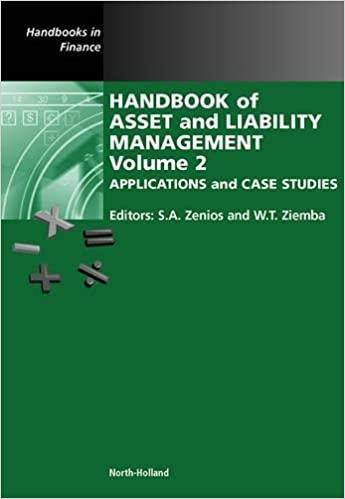Question
The Loan After his second meeting with the bank manager, Mr. Agarwal hurried home to share the great news with his wife. His loan application
The Loan After his second meeting with the bank manager, Mr. Agarwal hurried home to share the great news with his wife. His loan application has been approved. Certain conditions will have to be met, and the bank manager pointed out several areas for immediate attention, showing Mr. Agarwal that his company's performance was far from excellent. Nevertheless, the manager appreciated Mr. Agarwal's expert knowledge and experience in the field and agreed that the plan for Anandam's expansion was well thought-out and promising.
After carefully studying the details of Mr. Agarwal's business plan, the parties agreed that 45 million would be a sufficient amount of financing. The bank can supply the needed funds in the form of an amortizing loan at a 6.2 percent APR. The principal will be repaid in equal annual payments over the next 20 years. Moreover, considering the constraints associated with the first years of the expansion, Mr. Agarwal has an option to ask for a 5-year grace period on the principal payments. In that case, he would pay only the interest on the loan for the first five years and start repaying the principal in Year 6. Assignment
1. a) Based on the above details, prepare the loan amortization schedules for the two options (with and without the grace period) and calculate the total amount of interest to be paid over the life of the loan. Which of the two options would you recommend Mr. Agarwal to choose and why?
The Investment Plans
The central part of Anandams expansion plan includes building a new factory, and Mr. Agarwal has a series of innovative ideas to implement there. According to the preliminary schedule, the construction will start within a year, and the new facility should be fully operational three years later. To satisfy the immediate needs for expansion, Mr. Agarwal plans to purchase a manufacturing facility equipped with the used machines that he will sell or scrap after relocating production to the newly constructed space.
Mr. Agarwal has spent 180,000 researching all possible options and located two facilities that could satisfy Anandam's intermediate needs. Facility A can be used immediately upon purchasing, but its equipment, while in good condition, is relatively old and will have to be scrapped at the end of the five-year period. Facility B is more spacious and has a more convenient location, but Mr. Agarwal will need to replace some equipment at the outset. On the other hand, he will be able to sell the equipment upon moving production to his new factory.
Anandam's now full-time accountant calculated the costs associated with the two potential investments and estimated the net cash flows for the next five years. The results of his calculations are shown in Table 1. With all the figures at hand, Mr. Agarwal compared how soon he would be able to recover his investments in each case and concluded that he should purchase Facility A because of the faster payback period.
Assignment 2
a) Comment on Mr. Agarwals approach to making investment decisions. What are the advantages and shortcomings of the payback method?
b) Compute the Net Present Values, Internal Rates of Return, and Profitability indexes of the two projects and provide a recommendation based on the results of your calculations. Which of the three would be the best criterion to evaluate the potential investments in this situation? What are the disadvantages of the other two criteria?
c) Mr. Agarwals accountant has estimated that the appropriate discount rate for the investment projects in question is 12 percent. Assess the sensitivity of the projects NPVs to the discount rate in the range of +/3 percent and briefly comment on the results.
d) The accountant is fairly confident about his estimation of the initial cost of the investments. However, he thinks that his projections of the future cash flows are accurate within the range of +/20 percent. Calculate the worst-case and the best-case NPV based on the lower and upper bounds for the cash flow estimation. Do the results affect your recommendation made in (b)?
| Cost | Facility A | Facility B |
| Facility | 8300 | 7400 |
| New Equipment | 0 | 4184 |
| Total | 8300 | 11584 |
| Projected cash flows | ||
| Year 1 | 2190 | 2208 |
| Year 2 | 2784 | 2916 |
| Year 3 | 3336 | 3744 |
| Year 4 | 3828 | 4344 |
| Year 5 | 4200 | 9440 |
Step by Step Solution
There are 3 Steps involved in it
Step: 1

Get Instant Access to Expert-Tailored Solutions
See step-by-step solutions with expert insights and AI powered tools for academic success
Step: 2

Step: 3

Ace Your Homework with AI
Get the answers you need in no time with our AI-driven, step-by-step assistance
Get Started


